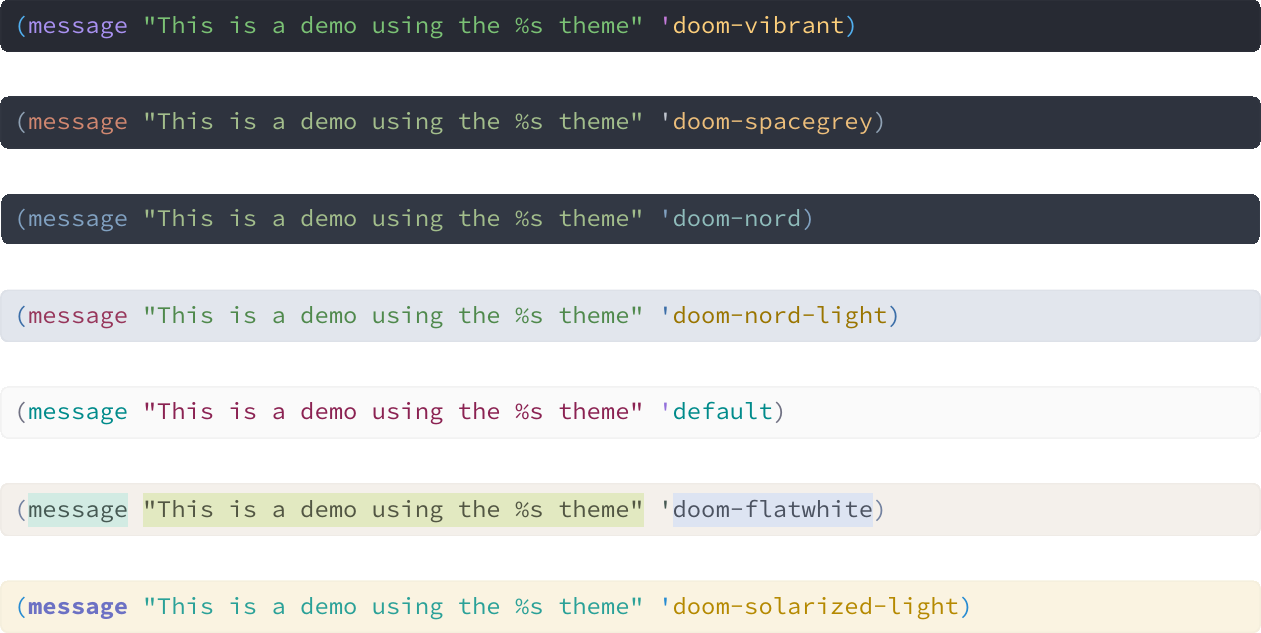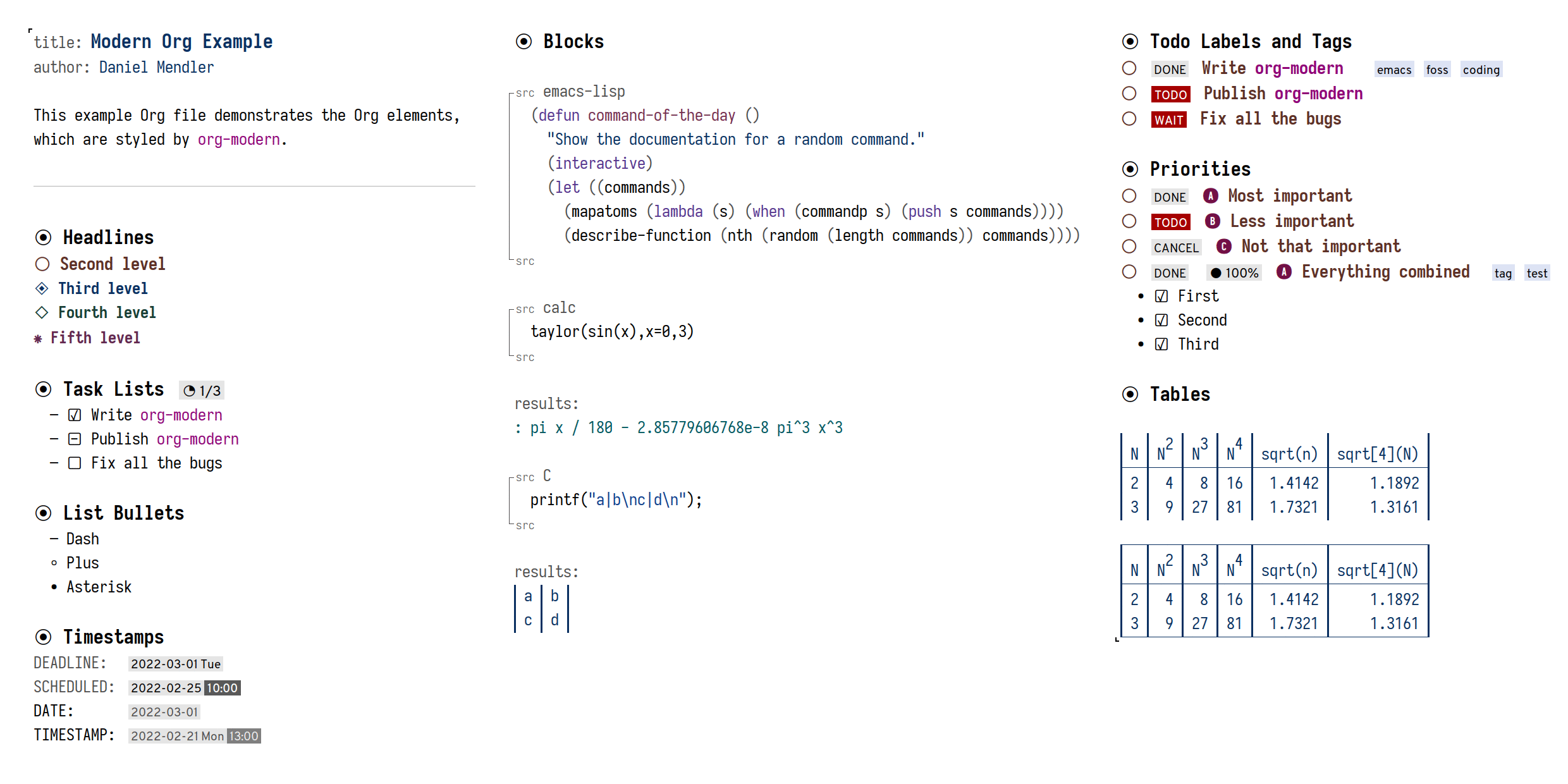May 2022
Folding more improvement into Org
Finding time as of late has been more difficult than I anticipated, and on top of that, just as I was thinking of writing last month’s post, I got distracted by an exciting patchset that has been in the works for over a year finally getting sorted out and landing. So, I hope that some of the fun developments in this post will make up the absense of the last one 🙂.
Since it’s been longer than I thought since the last standard post, we’ve got a fair few commits to catch up on — about 200. Most of these are miscellaneous minor improvements and bugfixes, but a few notable changes have arrived too.
Folding
The fabulous new folding engine (org-fold-core) should noticeably improve Org’s performance with large files. It contains a number of key optimisations to improve speed, namely:
- Deferring fontification of folded regions
- Using text properties (\(\mathcal{O}(n \log n)\)) instead of overlays (\(\mathcal{O}(n^2)\)) for folded regions
- A collection of aggressive optimisations available under
org-fold-core--optimise-for-huge-buffers - Convert text properties to overlays for isearch (which currently only supports overlays)
How noticeable is the overall performance impact? Well, I poked Ihor and he was kind enough to whip up some benchmarks.
org-shifttab showing file contents, as file size increases, with and without org-fold.org-shifttab showing the entire file, as file size increases, with and without org-fold.Well this looks very promising1! Let’s see how much of an improvement this is overall.
| File size (Mb) | Headings (thousands) | Bugfix (no org-fold) | Main (with org-fold) | Improvement |
|---|---|---|---|---|
| 18 | 36 | 115.31 | 0.89 | 99% |
| 8.8 | 24 | 19.03 | 0.48 | 97% |
| 4.4 | 5 | 3.79 | 0.13 | 97% |
| 2.2 | 2 | 1.29 | 0.08 | 94% |
| 1.1 | 1 | 0.50 | 0.045 | 91% |
To be clear, even the smallest file in this data — a 1.1 Mb Org file with around a thousand headings, is fairly large. So, it’s unlikely you’ll notice much of a difference with small–medium files, but if you a few large+ files this should be a fantastic improvement. Once again, thanks Ihor!
The change to text properties instead of overlays breaks a number of third party
packages like evil-search and consult’s consult-line.
If you are involved in any packages affected by this, you’ll either want to
consider supporting invisible text, or look at isearch-filter-predicate and
isearch-mode-end-hook, which org-fold now uses.
If you’re an end-user, perhaps politely make an issue on the repo for a project
if no issue currently exists, and either:
- Stay off Org’s bleeding edge till the package ecosystem has adapted to this change
- Help the packages you use adapt to this change
- Set
org-fold-core-styletooverlaysto restore the old behaviour
Engraved source code blocks in LaTeX
All too often exporting code to LaTeX has been a disappointment, with lovely
syntax highlighting from Emacs major modes replaced with a markedly inferior
attempt by pygments (setting org-latex-listings to minted) in a colour scheme I
don’t really like.
A bit over a year ago, a project called engrave-faces started with the aim of making Emacs’ font-lock more exportable, like a generalised htmlize.el. This has recently been used to provide a new option for inline and block source code exports in LaTeX.

To use this, simply install the package and set org-latex-src-block-backend (a
rename of org-latex-listings to better reflect its usage) to engraved.
While this is sufficient to get started, this new backend also allows for some
new options. The theme used for engraving a source block can be set globally
with the new variable org-latex-engraved-theme, or per-file with the
#+latex_engraved_theme keyword. It takes either the name of a theme, or the
symbol t as a stand-in for the current theme.
The theme can also be set on a per-block level using the LaTeX attribute :engraved-theme.

Here’s what using these new capabilities looks like in practice.
Org mode
#+title: Engraving source blocks #+begin_src emacs-lisp (message "look ma, some %s" 'code) #+end_src #+begin_src shell echo "This is shell code" #+end_src
This may well be the best syntax-highlighting solution available for PDFs/LaTeX currently available, but I am a tad biased 😛.
TexInfo export improvements
Jonas Bernoulli has been using a custom TexInfo backend for Magit’s documentation for a while now, and over the past few months he’s worked the features he was missing into Org’s built-in TexInfo exporter.
Upstreaming like this always takes a fair bit of effort, so thank you Jonas for going through with this!
Toggle noweb prefix handling
Previously, whenever a noweb reference appeared on a non-empty line, a multi-line replacement would duplicate the content before the noweb reference.
Clearly, this is not always desirable, and this behaviour can now be turned of by setting the new header argument :noweb-prefix no.
Org mode
#+begin_src emacs-lisp :noweb yes :noweb-prefix no (setq example-data "<<example>>") #+end_src Will now expand to #+begin_src emacs-lisp (setq example-data "some multi-line content") #+end_src Instead of #+begin_src emacs-lisp (setq example-data "some (setq example-data "multiline (setq example-data "content") #+end_src
Package highlight: org-modern
I think we’ve all seen plenty of org-mode prettification packages before, so what makes Minad’s org-modern special? It’s actually doing something similar to Ihor’s org-fold improvements, switching out slower overlay-based approaches for text properties. I can confirm that switching out org-superstar-mode for org-modern has made a substantial improvement in my experience, halving the first-load time of my config.org to around 20 seconds. If you’re a fan of Org prettification and haven’t taken a look at this package, I highly recommend giving it a shot.

Other improvements
- Clean up some magic numbers in org-attach Marco Wahl
- Allow any command form in
org-attach-commands(including keyboard macros) Marco Wahl - Allow dest in
org-list-send-itemto be a buffer position Sacha Chua - Improve CSL-JSON date handling in oc-basic David Lukes
- Add TOML and desktop language aliases TEC
- Speed up cached bibliography retrieval in oc-basic Ihor Radchenko
- Allow setting PlantUML jar arguments Ihor Radchenko
- Allow for customisation of property separators with
org-property-separatorsTyler Grinn - New ox-latex maintainer, Daniel Fleischer
- More unit tests Kyle Keyer, Nick Dokos
- Documentation improvements Kyle Meyer, Juan Manuel Macias, Bastien, Karl Fogel, Cody Harris
Bugfixes
- An Emacs <28 bug in org-persist Ihor Radchenko
- Author extraction in oc-basic Nicolas Goaziou
- Fix behaviour of
org-copy-visiblewith adjacent tex andbuffer-invisibility-specKyle Meyer - Parsing of inline footnotes with parentheses Nicolas Goaziou
- Honor
default-directoryin ob-gnuplot Ihor Radchenko - Heading fontification bug Anders Johansson
- Template expansion where one key is a substring of another Andrew Arensburger
Footnotes:
Note the difference in scale, org-fold makes the most difference in the graph where the times are an order of magnitude more.